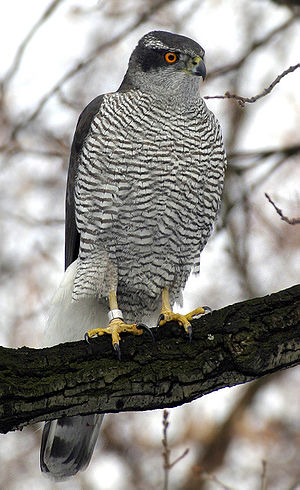 Image via Wikipedia
Image via WikipediaThe name "goshawk" comes from the Old English words gos, meaning goose, and hafoc meaning hawk. But even though it's the largest North American Accipiter, their most common prey are small mammals and birds found in forest habitats and not geese.
However, Goshawks have been prized for many centuries as a falconry bird for their speedy pursuits of prey and fearless demeanor. And records of traditional Japanese falconry, describes how the hawks were used regularly to hunt goose and crane species.
The United States Forest Service (US Dept of Agriculture) has listed the goshawk as a "sensitive species", primarily on the basis of historic and ongoing nesting habitat loss, specifically the loss of old-growth and mature forest stands throughout the goshawk's known range.
I've never seen a goshawk. In recent years, several states such as Michigan, Washington and Idaho have listed the birds as a "Species of Concern" and have increased conservation efforts focused on these birds. I think it is rare to see a goshawk in the suburbs of mid-Michigan. Thank you for letting us know about your sighting.
Further Information:
1) University of Michigan Museum of Zoology- Northern Goshawk Accipiter gentilis
2) Cornell University's "All About Birds - Northern Goshawk
3) Wikipedia- Northern Goshawk



No comments:
Post a Comment